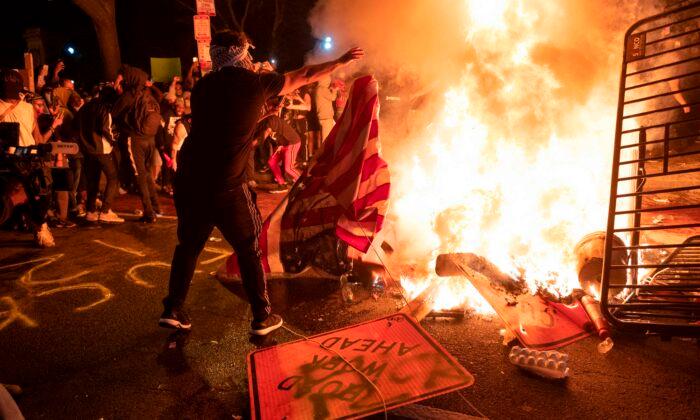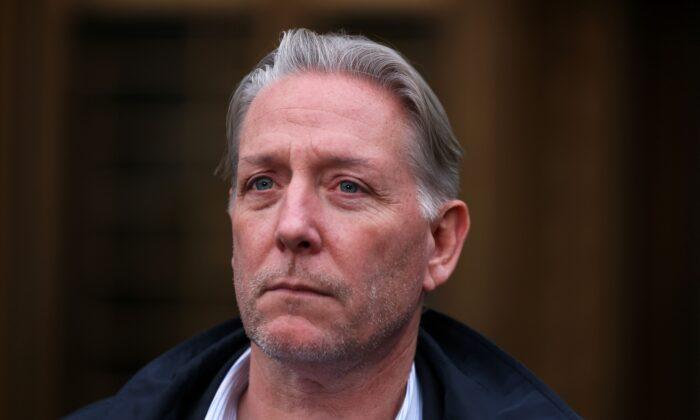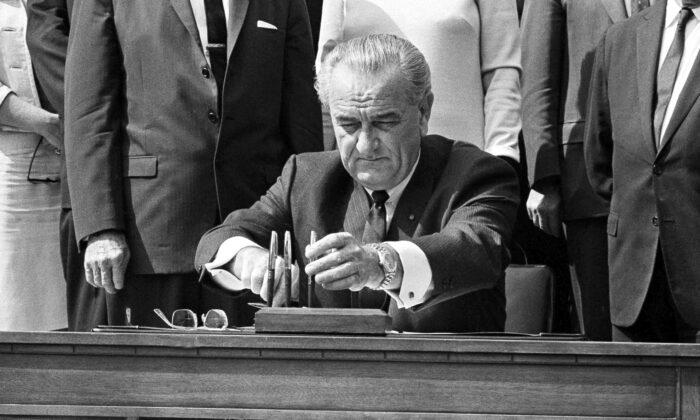WASHINGTON, D.C.—“But she told me she was 16 years old.”
Under a new criminal code being considered by the District of Columbia city council, that statement would be what is called “an affirmative defense to liability” for an adult who has sex with a minor. Put more plainly, an adult accused of sexual activity with a minor could avoid culpability if found to have “reasonably” believed the child’s claim at the time to have reached the age of consent.
This more lenient approach to child sexual abuse is just one of many changes being considered by the council. A sweeping new criminal code would redefine what counts as a crime in the nation’s capital, how those accused of crimes are tried, and how those convicted are punished.
Although many states are pushing back against progressive criminal justice reforms amid rising rates of violent crime, liberal jurisdictions from east to west continue to push for more lenient sentencing. Washington, D.C., stands out for its softer approach in the face of a crime problem illustrated by a homicide rate that jumped from 24 per 100,000 residents in 2019, to 29 in 2020, and then to 34 in 2021.
Proponents say the changes are designed to reduce the number of people arrested, prosecuted, convicted, and incarcerated. As it now stands, the District’s criminal code “is out-of-sync with current public norms and best practices,” according to Richard Schmechel, a prime mover of its reform effort. Schmechel, until recently executive director of the D.C. Criminal Code Reform Commission, said the new approach will reduce “errors, arbitrariness, and bias” in the current system.
But critics warn that the changes now being considered will make it difficult to hold offenders responsible for crimes.
The proposed rewrite of the D.C. criminal code recommended by the reform commission, formed by the city council in 2016, would affect how the nation’s capital treats everything from murder to indecent exposure, from robbery to panhandling.
For example, it eliminates “accomplice liability for felony murder,” the legal principle that holds conspirators responsible if a killing is committed in the course of the crime. Currently, the wheelman waiting around the corner while his friend robs a bodega doesn’t have to pull a trigger or even be armed to be prosecuted for felony murder if the clerk is killed.
Changes to felony murder laws have long been a goal of activists striving to limit prison populations. “These laws impose sentences associated with murder on people who neither intended to kill nor anticipated a death, and even on those who did not participate in the killing,” says Nazgol Ghandnoosh, a senior research analyst with The Sentencing Project, an anti-incarceration group active in the effort to rewrite the D.C. criminal code. Punishing a lookout for someone else’s violent act violates “the principle of proportional sentencing, which is supposed to punish crimes based on their severity,” Ghandnoosh says. “These excessively punitive outcomes violate widely shared perceptions of justice.”
But Elana Suttenberg, special counsel at the U.S. attorney’s office for the District of Columbia, warns that the underlying concept of shared liability is an important tool for law enforcement. In testimony prepared for the D.C. council, she noted that this is especially true when a group or gang is involved, especially if it is not clear which specific member was responsible for a killing. Suttenberg said the change could lead to the possibility that “a gang rape perpetrated by two or more individuals that resulted in the victim’s death may result in no liability for murder, as it may not be possible to determine which defendant committed the lethal act.”
Or consider the law’s treatment of rioting. Currently, the District defines a riot as “a public disturbance involving an assemblage of 5 or more persons which by tumultuous and violent conduct or the threat thereof creates grave danger of damage or injury to property or persons.”
Leniency shown during the 2020 George Floyd riots aside, those who organize or encourage a riot face stiff penalties under the current code: If anyone is hurt in the rioting, or if the riot causes more than $5,000 in property damage, “every person who willfully incited or urged others to engage in the riot shall be punished by imprisonment for not more than 10 years.”
The newly proposed code would drop the language about incitement altogether, a change that would make it harder for authorities to hold those who promote rioting responsible. The new definition of “rioting” would require that police prove a long list of actions and occurrences before they are able to charge those involved in group violence. Under the new code, a rioter is not just one who “knowingly commits or attempts to commit a criminal bodily injury, taking of property, or damage to property,” but who is also “reckless as to the fact 7 or more other people are each personally and simultaneously committing or attempting to commit a criminal bodily injury, taking of property, or damage to property, in the area reasonably perceptible to the actor.” To make an arrest for rioting, police will have to have evidence of not just what the person being cuffed has done, but what others in a crowd were doing as well. Police would also have to somehow demonstrate that the actor was aware of what each of the others was doing. All of this in the midst of street melees. This new section can hardly be seen as empowering police to quell mob violence.
And though relaxing statutes involving the sexual exploitation of minors may seem a strange goal, it is not outside the progressive mainstream, which calls for reduced sentences even in such cases. Both in her work on the United States Sentencing Commission and as a federal D.C. circuit judge, the newly seated Supreme Court Justice advocated for reduced sentences for those found guilty of possessing child pornography as well as violent offenders and drug dealers.
Even when the new code retains old offenses, the punishments recommended would be reduced. One of the key goals of those seeking to reduce prison populations has been to get rid of mandatory minimum sentences. “It’s such a critical part of creating reform,” says Ghandnoosh. Currently, the mandatory minimum for those who commit premeditated first-degree murder is 30 years in prison. The minimum punishment for “committing a crime of violence while armed with a firearm” is five years behind bars. In the newly proposed code, there are no mandatory minimums at all.
There will, however, be new limits on the penalties judges will be able to hand out. The longest sentence that could be given for first-degree murder under the new code is 45 years. Some reformers think that is too severe. “We advocate a maximum of 20 years,” Ghandnoosh tells RealClearInvestigations. Still, she says, it is “notable to move away from life sentences.” This effort has been a key goal of billionaire activist George Soros, whose Open Society Foundations has funded the Sentencing Project for over two decades.
Perhaps the most consequential of the proposed reforms have to do with the minor-league offenses adjudicated at the courthouse: misdemeanors. They may be minor crimes, but the changes to prosecuting misdemeanors would have a major effect on the prosecution of more serious crimes.
Currently in the District of Columbia, felony prosecutions are heard by juries; a misdemeanor that goes to trial is, for the most part, heard by a judge. The commission recommends that misdemeanor defendants facing any possible incarceration be free to demand a jury trial. “We respect the right to a jury in appropriate cases,” says Suttenberg. But can the D.C. court system handle the added workload? Altogether, the eight courtrooms devoted to misdemeanors in the District hear somewhere between 110 and 170 cases a week; by contrast, each of the courtrooms reserved for felony trials schedule only one case a day. The D.C. Superior Court would soon be overwhelmed, bogged down in trying to find and empanel enough jurors and other time-consuming procedural requirements of jury trials. “Creating new rights to demand a jury in misdemeanor cases will strain both court and prosecutorial resources,” says Suttenberg.
If it is passed by the D.C. city council and signed by the mayor, the new code would provide a “judicial sentence review” for anyone who has served 15 years in prison. These “second-look provisions” are a key goal of the Sentencing Project. But others who have been part of the District’s criminal system are less enthusiastic about the “decarceration” that would follow. “Our system is designed to give criminal defendants extraordinary protections at the time of trial. At some point, the process should be afforded a presumption of finality,” says former D.C. Superior Court judge Stuart Nash. “It seems fundamentally unfair to make the government defend the legitimacy of a result many years later, and even more unfair that the victim of a crime cannot rely on the finality of that result.”
Sentencing reform is at the core of changes to the criminal code in the District. But the idea of “sentencing reform” is intentionally opaque, William Otis tells RealClearInvestigations. “Reform” of sentencing means “reduction,” says Otis, an adjunct professor of law at Georgetown University Law School. Special counsel to President George H.W. Bush, Otis was also chief of the appellate division of the U.S. attorney’s office for the Eastern District of Virginia. “We tried being nice,” he says of the lenient sentencing of the 1960s and 1970s. “What we got in exchange was a gigantic increase in crime.”
Cleanup in the Legislative Aisles
The District of Columbia is not the only place rewriting its criminal code—although rising crime is forcing reconsiderations elsewhere. Reform-minded Colorado’s legislature revised, if not reversed, last year’s reduction of the number of misdemeanors on its books, what had been Senate Bill 21-271. This year the legislature passed “The Senate Bill 21-271 Clean Up.” It was signed by the governor last month.Colorado’s crime rate is soaring, with car theft up more than 80 percent from 2019 to 2021. And while it might be unfair to attribute such a rise to the 2021 code changes, since they took effect only two months ago, it doesn’t help the cause of reform for changes to kick in when voters are experiencing the anxiety and uncertainty that comes with rising crime.
Similarly, New Hampshire in 2018 passed bail reforms making it significantly easier for those accused of violent crimes to get bail automatically. Many, such as Manchester Police Department chief Allen Aldenberg, have argued that the changes to bail laws put dangerous criminals on the street. “What’s it going to take?” Aldenberg asked state legislators. “Someone being murdered by somebody that’s out on bail two, three times over?” New Hampshire lawmakers nearly passed legislation early this month to tighten the availability of bail. The narrow failure of the bill was an illustration of how difficult it is to undo changes to policing and prosecution once those revisions are on the books.
Like the District of Columbia, other jurisdictions have established official advisory groups setting out how to rewrite criminal laws, such as California’s Committee on Revision of the Penal Code. Several of its recommendations have already been adopted, including the elimination of mandatory minimum sentences in the case of non-violent crimes.
In its 2020 report, the California committee cited statistics it claimed showed there was no threat to public safety from the sort of reforms it recommended. “According to the most recent data from the California Department of Justice, California has the lowest crime rates since comprehensive statewide statistics were first recorded in 1969,” the committee reported, citing crime figures through 2019. “This continues a 30-year trend of steadily decreasing crime rates. At the same time, the state has enacted laws that markedly reduced the number of people incarcerated in its state prison system.”
But California crime statistics for 2020 proved to be less of an advertisement for the changes promoted by the committee. Overall, the rate of violent crime increased. For example, there were 104,756 aggravated assaults in 2019; in 2020 there were 113,539. Rape and robbery rates did fall slightly, but from 2019 to 2020 the homicide rate went up 31 percent. The rate at which police “cleared” homicides fell to its lowest in a decade.
“It’s simple,” says John Lott, former chief economist for the U.S. Sentencing Commission. He tells RealClearInvestigations, “If you make it less risky to commit a crime, you will get more of the crime.”
Or, as William Otis puts it, “This is not rocket science. If we go back to the failed policies of the past, we'll get the failed results of the past.”
“The sole beneficiaries” of the sort of reforms being pursued in the District of Columbia, California, and Colorado “will be criminals,” says Otis. “Is that what we need right now?”







Friends Read Free